Thesis: Health Literacy, STDs, and Young People in Washington DC
VerifiedAdded on 2021/04/17
|7
|1773
|110
Thesis and Dissertation
AI Summary
This thesis delves into the critical relationship between health literacy and the prevalence of sexually transmitted diseases (STDs) among young people aged 13 to 18 in Washington DC. The study investigates the causes of low health literacy, considering factors such as age, educational background, and the influence of peer norms and media. The research employs questionnaires, document analysis, and interviews to assess the target population's understanding of health issues and views on STDs. It highlights the role of inadequate sex education, disregard for health information, and barriers to healthcare access, including financial constraints and transportation issues. The thesis concludes by emphasizing the importance of health education programs tailored to the needs of young adults, the need for maintaining confidentiality in healthcare, and the importance of healthcare providers customizing clinical management according to patient literacy levels.
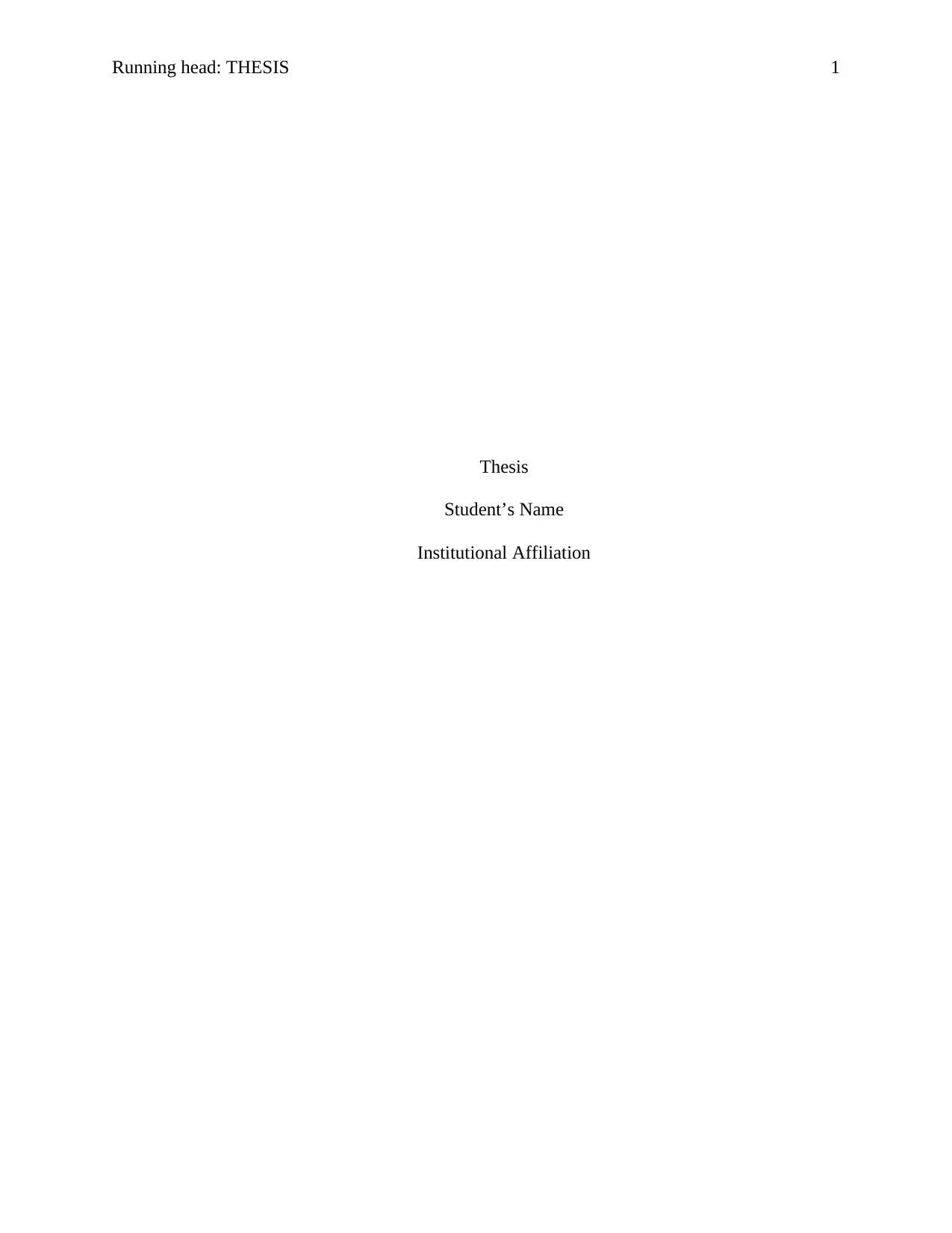
Running head: THESIS 1
Thesis
Student’s Name
Institutional Affiliation
Thesis
Student’s Name
Institutional Affiliation
Paraphrase This Document
Need a fresh take? Get an instant paraphrase of this document with our AI Paraphraser
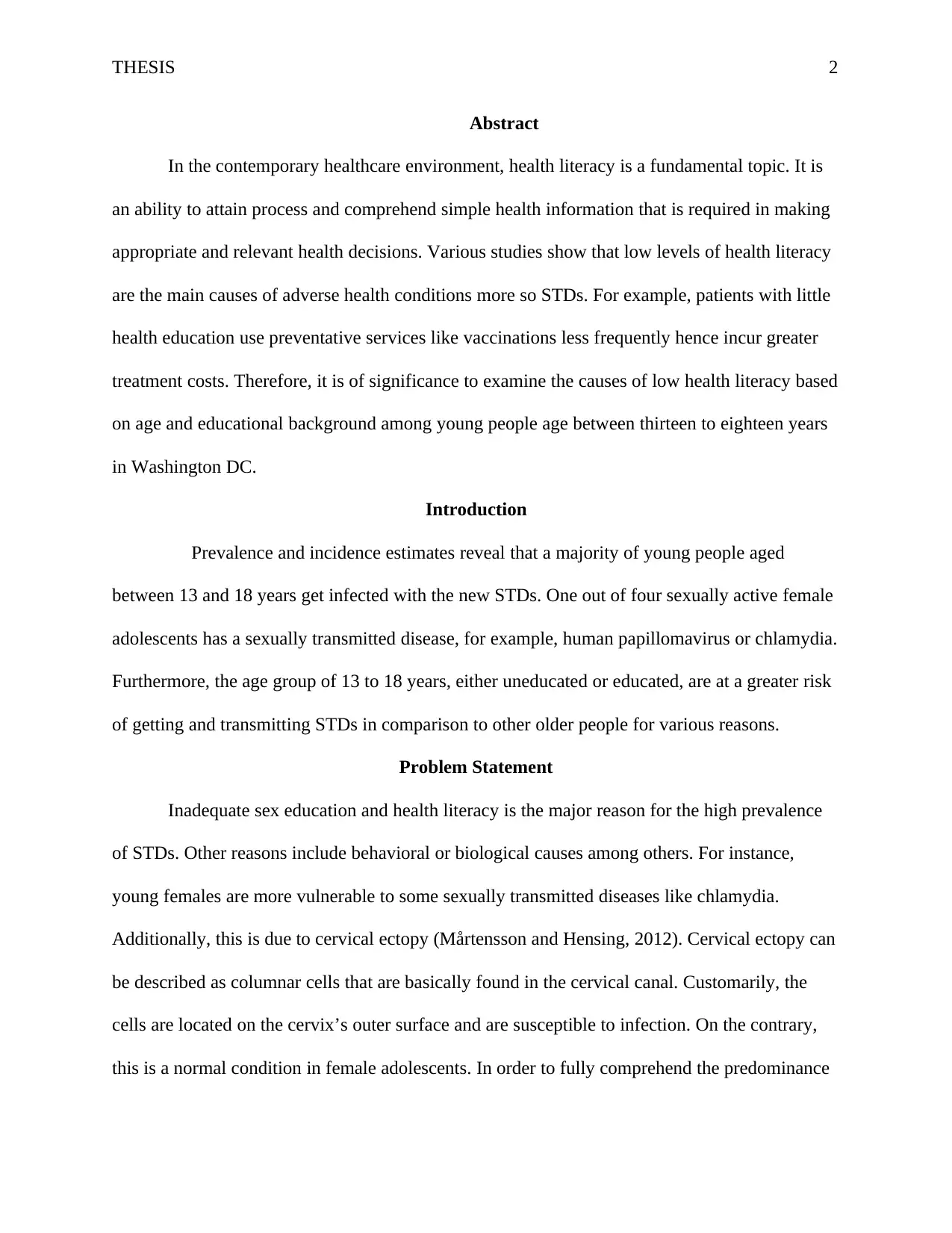
THESIS 2
Abstract
In the contemporary healthcare environment, health literacy is a fundamental topic. It is
an ability to attain process and comprehend simple health information that is required in making
appropriate and relevant health decisions. Various studies show that low levels of health literacy
are the main causes of adverse health conditions more so STDs. For example, patients with little
health education use preventative services like vaccinations less frequently hence incur greater
treatment costs. Therefore, it is of significance to examine the causes of low health literacy based
on age and educational background among young people age between thirteen to eighteen years
in Washington DC.
Introduction
Prevalence and incidence estimates reveal that a majority of young people aged
between 13 and 18 years get infected with the new STDs. One out of four sexually active female
adolescents has a sexually transmitted disease, for example, human papillomavirus or chlamydia.
Furthermore, the age group of 13 to 18 years, either uneducated or educated, are at a greater risk
of getting and transmitting STDs in comparison to other older people for various reasons.
Problem Statement
Inadequate sex education and health literacy is the major reason for the high prevalence
of STDs. Other reasons include behavioral or biological causes among others. For instance,
young females are more vulnerable to some sexually transmitted diseases like chlamydia.
Additionally, this is due to cervical ectopy (Mårtensson and Hensing, 2012). Cervical ectopy can
be described as columnar cells that are basically found in the cervical canal. Customarily, the
cells are located on the cervix’s outer surface and are susceptible to infection. On the contrary,
this is a normal condition in female adolescents. In order to fully comprehend the predominance
Abstract
In the contemporary healthcare environment, health literacy is a fundamental topic. It is
an ability to attain process and comprehend simple health information that is required in making
appropriate and relevant health decisions. Various studies show that low levels of health literacy
are the main causes of adverse health conditions more so STDs. For example, patients with little
health education use preventative services like vaccinations less frequently hence incur greater
treatment costs. Therefore, it is of significance to examine the causes of low health literacy based
on age and educational background among young people age between thirteen to eighteen years
in Washington DC.
Introduction
Prevalence and incidence estimates reveal that a majority of young people aged
between 13 and 18 years get infected with the new STDs. One out of four sexually active female
adolescents has a sexually transmitted disease, for example, human papillomavirus or chlamydia.
Furthermore, the age group of 13 to 18 years, either uneducated or educated, are at a greater risk
of getting and transmitting STDs in comparison to other older people for various reasons.
Problem Statement
Inadequate sex education and health literacy is the major reason for the high prevalence
of STDs. Other reasons include behavioral or biological causes among others. For instance,
young females are more vulnerable to some sexually transmitted diseases like chlamydia.
Additionally, this is due to cervical ectopy (Mårtensson and Hensing, 2012). Cervical ectopy can
be described as columnar cells that are basically found in the cervical canal. Customarily, the
cells are located on the cervix’s outer surface and are susceptible to infection. On the contrary,
this is a normal condition in female adolescents. In order to fully comprehend the predominance
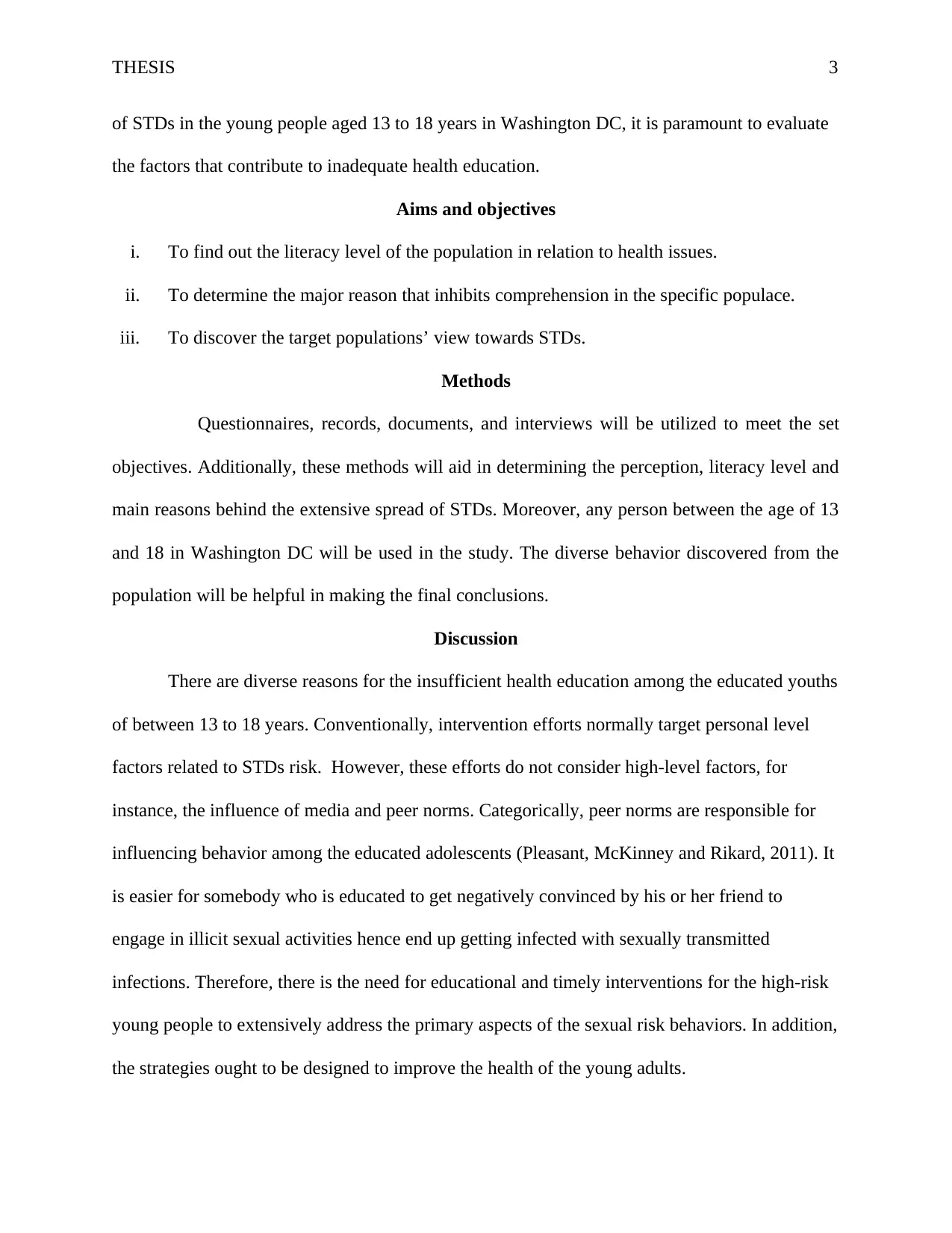
THESIS 3
of STDs in the young people aged 13 to 18 years in Washington DC, it is paramount to evaluate
the factors that contribute to inadequate health education.
Aims and objectives
i. To find out the literacy level of the population in relation to health issues.
ii. To determine the major reason that inhibits comprehension in the specific populace.
iii. To discover the target populations’ view towards STDs.
Methods
Questionnaires, records, documents, and interviews will be utilized to meet the set
objectives. Additionally, these methods will aid in determining the perception, literacy level and
main reasons behind the extensive spread of STDs. Moreover, any person between the age of 13
and 18 in Washington DC will be used in the study. The diverse behavior discovered from the
population will be helpful in making the final conclusions.
Discussion
There are diverse reasons for the insufficient health education among the educated youths
of between 13 to 18 years. Conventionally, intervention efforts normally target personal level
factors related to STDs risk. However, these efforts do not consider high-level factors, for
instance, the influence of media and peer norms. Categorically, peer norms are responsible for
influencing behavior among the educated adolescents (Pleasant, McKinney and Rikard, 2011). It
is easier for somebody who is educated to get negatively convinced by his or her friend to
engage in illicit sexual activities hence end up getting infected with sexually transmitted
infections. Therefore, there is the need for educational and timely interventions for the high-risk
young people to extensively address the primary aspects of the sexual risk behaviors. In addition,
the strategies ought to be designed to improve the health of the young adults.
of STDs in the young people aged 13 to 18 years in Washington DC, it is paramount to evaluate
the factors that contribute to inadequate health education.
Aims and objectives
i. To find out the literacy level of the population in relation to health issues.
ii. To determine the major reason that inhibits comprehension in the specific populace.
iii. To discover the target populations’ view towards STDs.
Methods
Questionnaires, records, documents, and interviews will be utilized to meet the set
objectives. Additionally, these methods will aid in determining the perception, literacy level and
main reasons behind the extensive spread of STDs. Moreover, any person between the age of 13
and 18 in Washington DC will be used in the study. The diverse behavior discovered from the
population will be helpful in making the final conclusions.
Discussion
There are diverse reasons for the insufficient health education among the educated youths
of between 13 to 18 years. Conventionally, intervention efforts normally target personal level
factors related to STDs risk. However, these efforts do not consider high-level factors, for
instance, the influence of media and peer norms. Categorically, peer norms are responsible for
influencing behavior among the educated adolescents (Pleasant, McKinney and Rikard, 2011). It
is easier for somebody who is educated to get negatively convinced by his or her friend to
engage in illicit sexual activities hence end up getting infected with sexually transmitted
infections. Therefore, there is the need for educational and timely interventions for the high-risk
young people to extensively address the primary aspects of the sexual risk behaviors. In addition,
the strategies ought to be designed to improve the health of the young adults.
⊘ This is a preview!⊘
Do you want full access?
Subscribe today to unlock all pages.

Trusted by 1+ million students worldwide
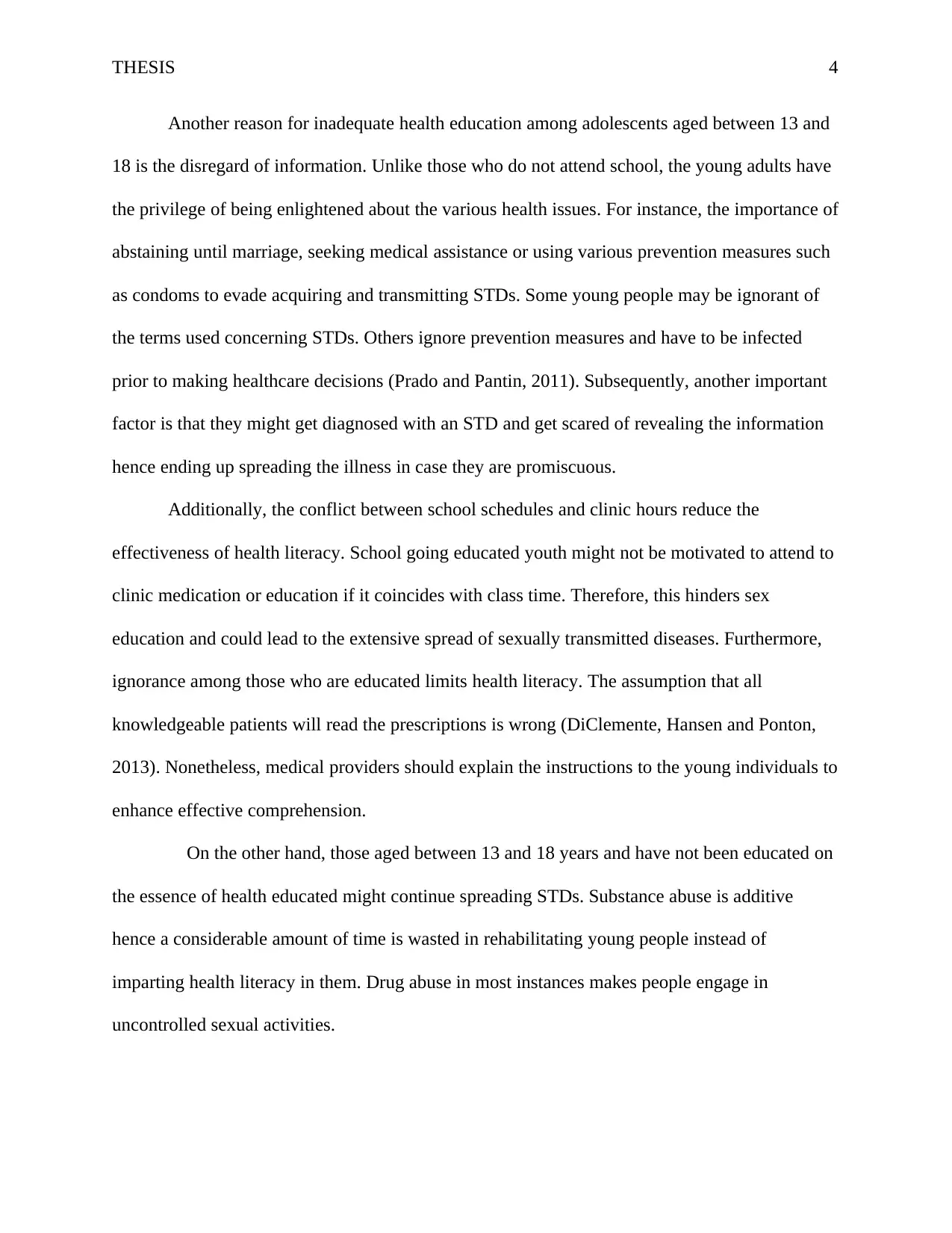
THESIS 4
Another reason for inadequate health education among adolescents aged between 13 and
18 is the disregard of information. Unlike those who do not attend school, the young adults have
the privilege of being enlightened about the various health issues. For instance, the importance of
abstaining until marriage, seeking medical assistance or using various prevention measures such
as condoms to evade acquiring and transmitting STDs. Some young people may be ignorant of
the terms used concerning STDs. Others ignore prevention measures and have to be infected
prior to making healthcare decisions (Prado and Pantin, 2011). Subsequently, another important
factor is that they might get diagnosed with an STD and get scared of revealing the information
hence ending up spreading the illness in case they are promiscuous.
Additionally, the conflict between school schedules and clinic hours reduce the
effectiveness of health literacy. School going educated youth might not be motivated to attend to
clinic medication or education if it coincides with class time. Therefore, this hinders sex
education and could lead to the extensive spread of sexually transmitted diseases. Furthermore,
ignorance among those who are educated limits health literacy. The assumption that all
knowledgeable patients will read the prescriptions is wrong (DiClemente, Hansen and Ponton,
2013). Nonetheless, medical providers should explain the instructions to the young individuals to
enhance effective comprehension.
On the other hand, those aged between 13 and 18 years and have not been educated on
the essence of health educated might continue spreading STDs. Substance abuse is additive
hence a considerable amount of time is wasted in rehabilitating young people instead of
imparting health literacy in them. Drug abuse in most instances makes people engage in
uncontrolled sexual activities.
Another reason for inadequate health education among adolescents aged between 13 and
18 is the disregard of information. Unlike those who do not attend school, the young adults have
the privilege of being enlightened about the various health issues. For instance, the importance of
abstaining until marriage, seeking medical assistance or using various prevention measures such
as condoms to evade acquiring and transmitting STDs. Some young people may be ignorant of
the terms used concerning STDs. Others ignore prevention measures and have to be infected
prior to making healthcare decisions (Prado and Pantin, 2011). Subsequently, another important
factor is that they might get diagnosed with an STD and get scared of revealing the information
hence ending up spreading the illness in case they are promiscuous.
Additionally, the conflict between school schedules and clinic hours reduce the
effectiveness of health literacy. School going educated youth might not be motivated to attend to
clinic medication or education if it coincides with class time. Therefore, this hinders sex
education and could lead to the extensive spread of sexually transmitted diseases. Furthermore,
ignorance among those who are educated limits health literacy. The assumption that all
knowledgeable patients will read the prescriptions is wrong (DiClemente, Hansen and Ponton,
2013). Nonetheless, medical providers should explain the instructions to the young individuals to
enhance effective comprehension.
On the other hand, those aged between 13 and 18 years and have not been educated on
the essence of health educated might continue spreading STDs. Substance abuse is additive
hence a considerable amount of time is wasted in rehabilitating young people instead of
imparting health literacy in them. Drug abuse in most instances makes people engage in
uncontrolled sexual activities.
Paraphrase This Document
Need a fresh take? Get an instant paraphrase of this document with our AI Paraphraser
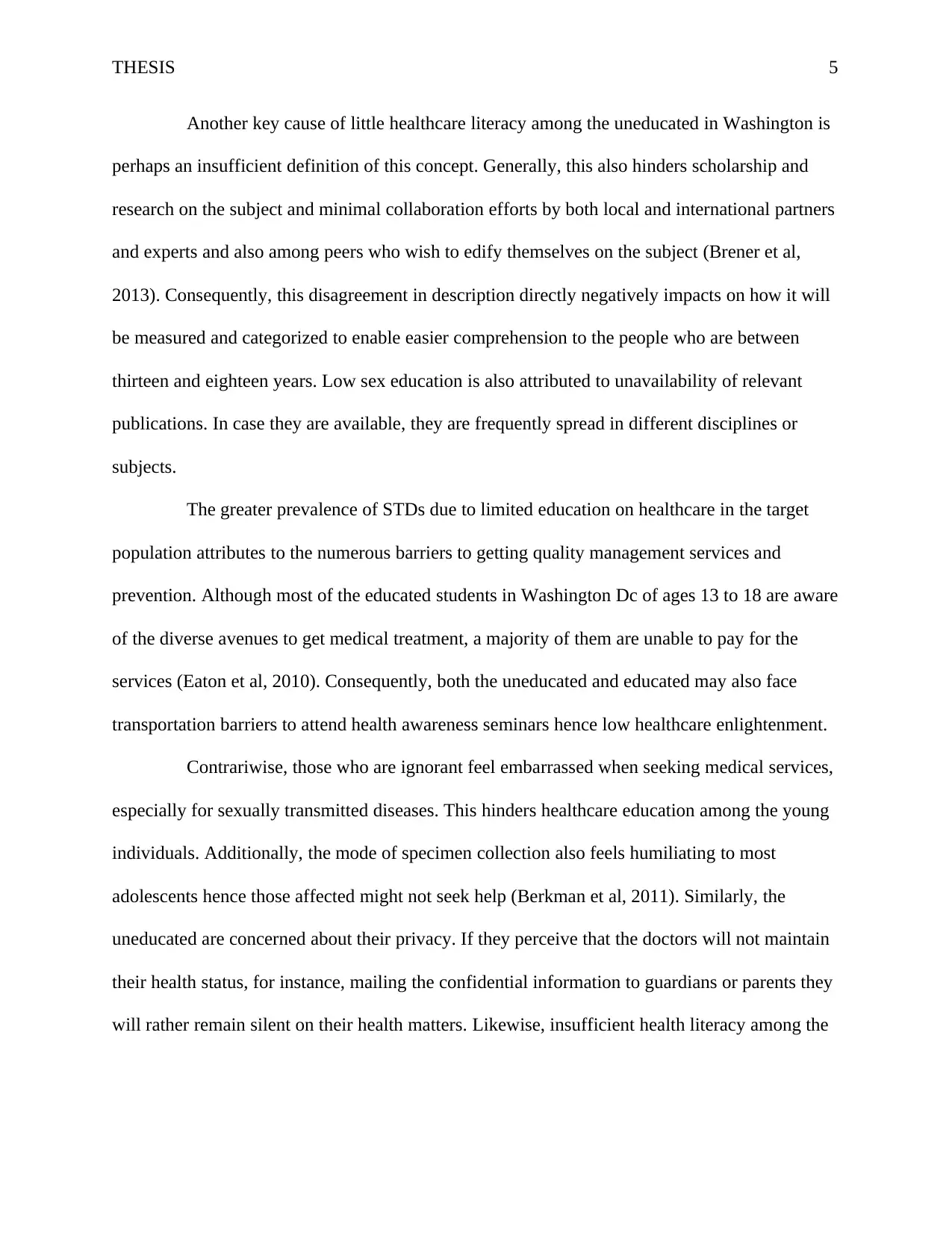
THESIS 5
Another key cause of little healthcare literacy among the uneducated in Washington is
perhaps an insufficient definition of this concept. Generally, this also hinders scholarship and
research on the subject and minimal collaboration efforts by both local and international partners
and experts and also among peers who wish to edify themselves on the subject (Brener et al,
2013). Consequently, this disagreement in description directly negatively impacts on how it will
be measured and categorized to enable easier comprehension to the people who are between
thirteen and eighteen years. Low sex education is also attributed to unavailability of relevant
publications. In case they are available, they are frequently spread in different disciplines or
subjects.
The greater prevalence of STDs due to limited education on healthcare in the target
population attributes to the numerous barriers to getting quality management services and
prevention. Although most of the educated students in Washington Dc of ages 13 to 18 are aware
of the diverse avenues to get medical treatment, a majority of them are unable to pay for the
services (Eaton et al, 2010). Consequently, both the uneducated and educated may also face
transportation barriers to attend health awareness seminars hence low healthcare enlightenment.
Contrariwise, those who are ignorant feel embarrassed when seeking medical services,
especially for sexually transmitted diseases. This hinders healthcare education among the young
individuals. Additionally, the mode of specimen collection also feels humiliating to most
adolescents hence those affected might not seek help (Berkman et al, 2011). Similarly, the
uneducated are concerned about their privacy. If they perceive that the doctors will not maintain
their health status, for instance, mailing the confidential information to guardians or parents they
will rather remain silent on their health matters. Likewise, insufficient health literacy among the
Another key cause of little healthcare literacy among the uneducated in Washington is
perhaps an insufficient definition of this concept. Generally, this also hinders scholarship and
research on the subject and minimal collaboration efforts by both local and international partners
and experts and also among peers who wish to edify themselves on the subject (Brener et al,
2013). Consequently, this disagreement in description directly negatively impacts on how it will
be measured and categorized to enable easier comprehension to the people who are between
thirteen and eighteen years. Low sex education is also attributed to unavailability of relevant
publications. In case they are available, they are frequently spread in different disciplines or
subjects.
The greater prevalence of STDs due to limited education on healthcare in the target
population attributes to the numerous barriers to getting quality management services and
prevention. Although most of the educated students in Washington Dc of ages 13 to 18 are aware
of the diverse avenues to get medical treatment, a majority of them are unable to pay for the
services (Eaton et al, 2010). Consequently, both the uneducated and educated may also face
transportation barriers to attend health awareness seminars hence low healthcare enlightenment.
Contrariwise, those who are ignorant feel embarrassed when seeking medical services,
especially for sexually transmitted diseases. This hinders healthcare education among the young
individuals. Additionally, the mode of specimen collection also feels humiliating to most
adolescents hence those affected might not seek help (Berkman et al, 2011). Similarly, the
uneducated are concerned about their privacy. If they perceive that the doctors will not maintain
their health status, for instance, mailing the confidential information to guardians or parents they
will rather remain silent on their health matters. Likewise, insufficient health literacy among the
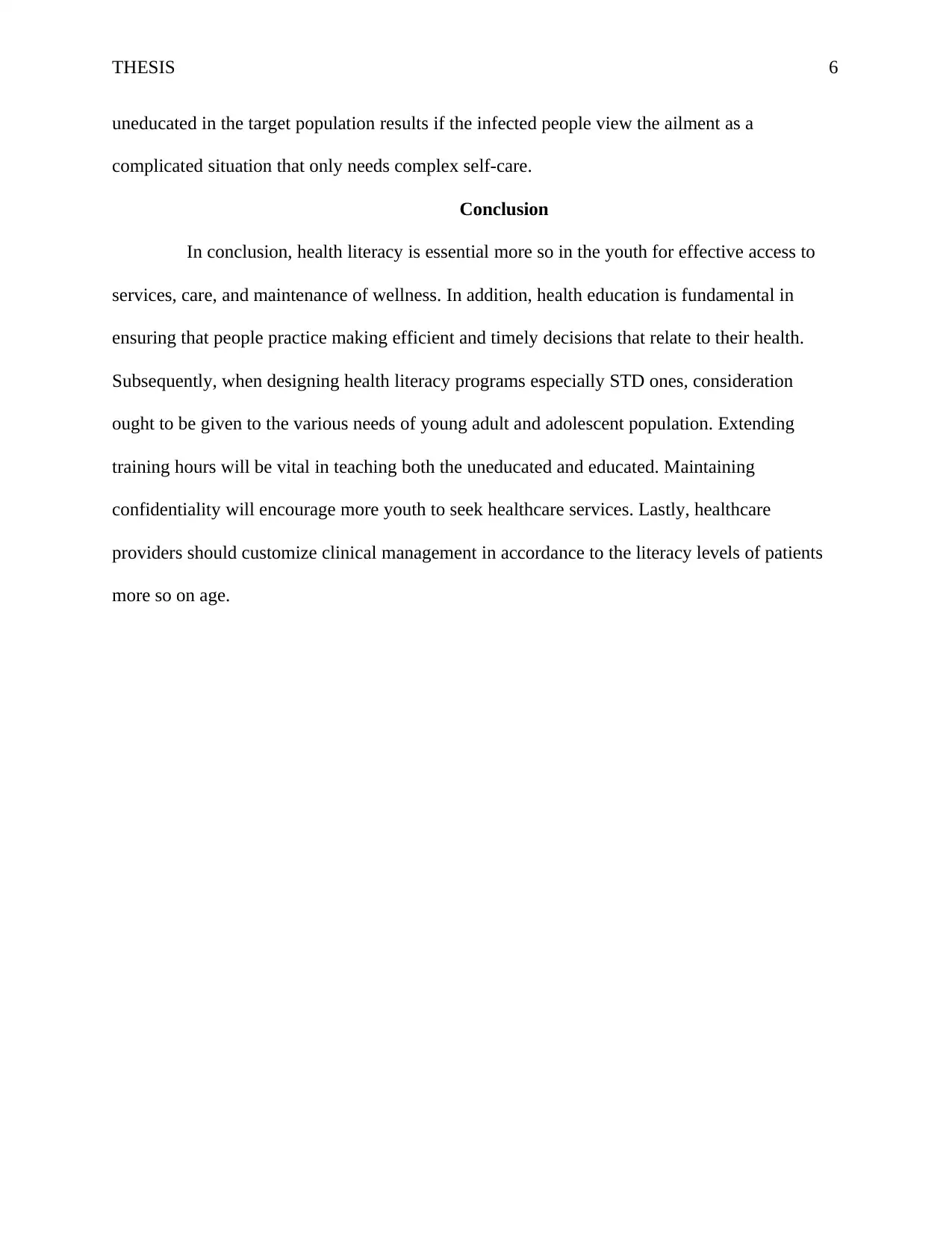
THESIS 6
uneducated in the target population results if the infected people view the ailment as a
complicated situation that only needs complex self-care.
Conclusion
In conclusion, health literacy is essential more so in the youth for effective access to
services, care, and maintenance of wellness. In addition, health education is fundamental in
ensuring that people practice making efficient and timely decisions that relate to their health.
Subsequently, when designing health literacy programs especially STD ones, consideration
ought to be given to the various needs of young adult and adolescent population. Extending
training hours will be vital in teaching both the uneducated and educated. Maintaining
confidentiality will encourage more youth to seek healthcare services. Lastly, healthcare
providers should customize clinical management in accordance to the literacy levels of patients
more so on age.
uneducated in the target population results if the infected people view the ailment as a
complicated situation that only needs complex self-care.
Conclusion
In conclusion, health literacy is essential more so in the youth for effective access to
services, care, and maintenance of wellness. In addition, health education is fundamental in
ensuring that people practice making efficient and timely decisions that relate to their health.
Subsequently, when designing health literacy programs especially STD ones, consideration
ought to be given to the various needs of young adult and adolescent population. Extending
training hours will be vital in teaching both the uneducated and educated. Maintaining
confidentiality will encourage more youth to seek healthcare services. Lastly, healthcare
providers should customize clinical management in accordance to the literacy levels of patients
more so on age.
⊘ This is a preview!⊘
Do you want full access?
Subscribe today to unlock all pages.

Trusted by 1+ million students worldwide
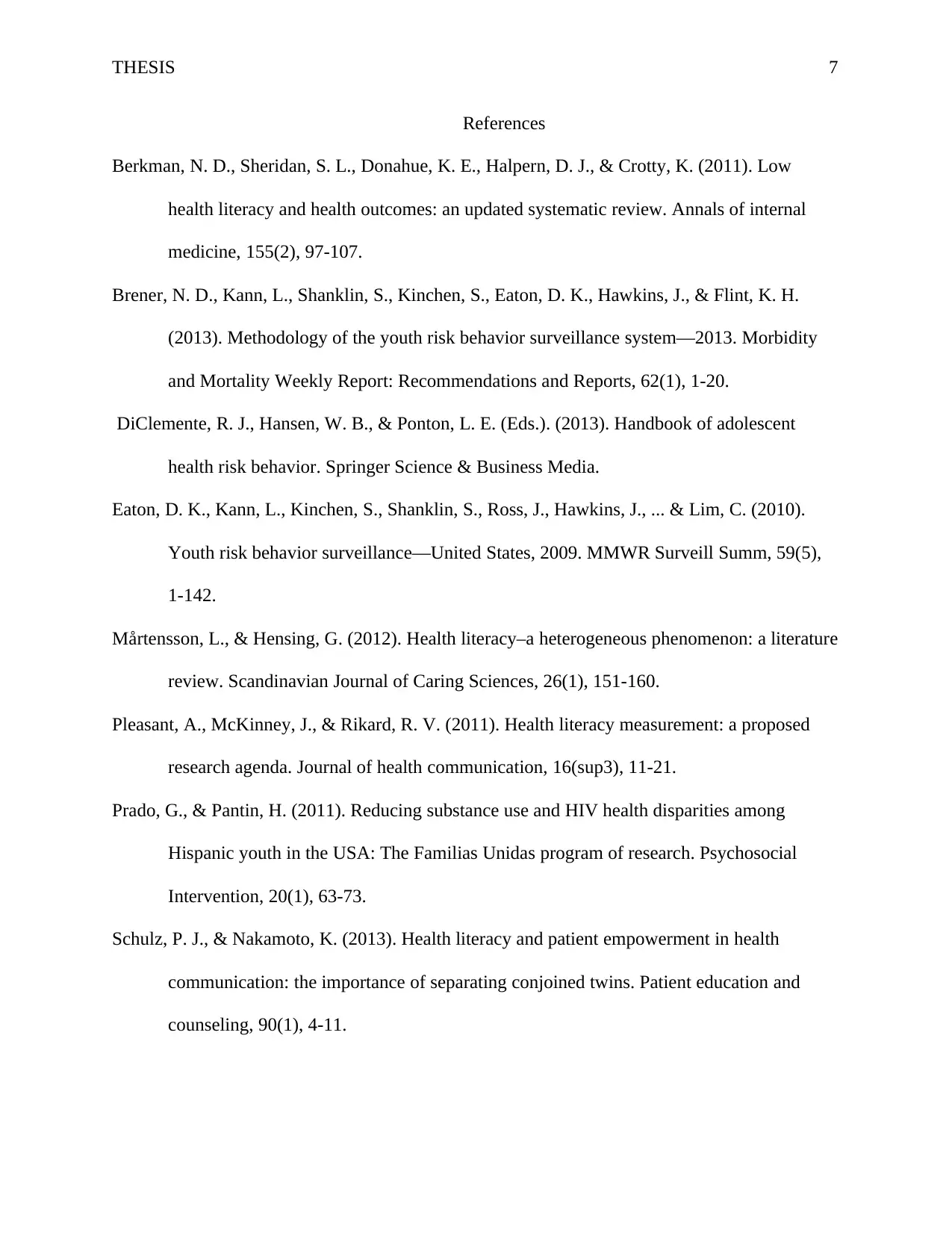
THESIS 7
References
Berkman, N. D., Sheridan, S. L., Donahue, K. E., Halpern, D. J., & Crotty, K. (2011). Low
health literacy and health outcomes: an updated systematic review. Annals of internal
medicine, 155(2), 97-107.
Brener, N. D., Kann, L., Shanklin, S., Kinchen, S., Eaton, D. K., Hawkins, J., & Flint, K. H.
(2013). Methodology of the youth risk behavior surveillance system—2013. Morbidity
and Mortality Weekly Report: Recommendations and Reports, 62(1), 1-20.
DiClemente, R. J., Hansen, W. B., & Ponton, L. E. (Eds.). (2013). Handbook of adolescent
health risk behavior. Springer Science & Business Media.
Eaton, D. K., Kann, L., Kinchen, S., Shanklin, S., Ross, J., Hawkins, J., ... & Lim, C. (2010).
Youth risk behavior surveillance—United States, 2009. MMWR Surveill Summ, 59(5),
1-142.
Mårtensson, L., & Hensing, G. (2012). Health literacy–a heterogeneous phenomenon: a literature
review. Scandinavian Journal of Caring Sciences, 26(1), 151-160.
Pleasant, A., McKinney, J., & Rikard, R. V. (2011). Health literacy measurement: a proposed
research agenda. Journal of health communication, 16(sup3), 11-21.
Prado, G., & Pantin, H. (2011). Reducing substance use and HIV health disparities among
Hispanic youth in the USA: The Familias Unidas program of research. Psychosocial
Intervention, 20(1), 63-73.
Schulz, P. J., & Nakamoto, K. (2013). Health literacy and patient empowerment in health
communication: the importance of separating conjoined twins. Patient education and
counseling, 90(1), 4-11.
References
Berkman, N. D., Sheridan, S. L., Donahue, K. E., Halpern, D. J., & Crotty, K. (2011). Low
health literacy and health outcomes: an updated systematic review. Annals of internal
medicine, 155(2), 97-107.
Brener, N. D., Kann, L., Shanklin, S., Kinchen, S., Eaton, D. K., Hawkins, J., & Flint, K. H.
(2013). Methodology of the youth risk behavior surveillance system—2013. Morbidity
and Mortality Weekly Report: Recommendations and Reports, 62(1), 1-20.
DiClemente, R. J., Hansen, W. B., & Ponton, L. E. (Eds.). (2013). Handbook of adolescent
health risk behavior. Springer Science & Business Media.
Eaton, D. K., Kann, L., Kinchen, S., Shanklin, S., Ross, J., Hawkins, J., ... & Lim, C. (2010).
Youth risk behavior surveillance—United States, 2009. MMWR Surveill Summ, 59(5),
1-142.
Mårtensson, L., & Hensing, G. (2012). Health literacy–a heterogeneous phenomenon: a literature
review. Scandinavian Journal of Caring Sciences, 26(1), 151-160.
Pleasant, A., McKinney, J., & Rikard, R. V. (2011). Health literacy measurement: a proposed
research agenda. Journal of health communication, 16(sup3), 11-21.
Prado, G., & Pantin, H. (2011). Reducing substance use and HIV health disparities among
Hispanic youth in the USA: The Familias Unidas program of research. Psychosocial
Intervention, 20(1), 63-73.
Schulz, P. J., & Nakamoto, K. (2013). Health literacy and patient empowerment in health
communication: the importance of separating conjoined twins. Patient education and
counseling, 90(1), 4-11.
1 out of 7
Related Documents
Your All-in-One AI-Powered Toolkit for Academic Success.
+13062052269
info@desklib.com
Available 24*7 on WhatsApp / Email
![[object Object]](/_next/static/media/star-bottom.7253800d.svg)
Unlock your academic potential
Copyright © 2020–2025 A2Z Services. All Rights Reserved. Developed and managed by ZUCOL.





